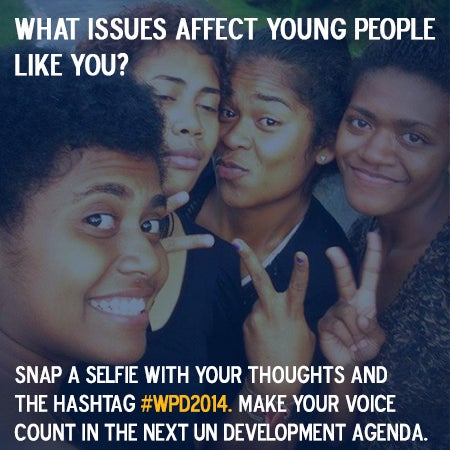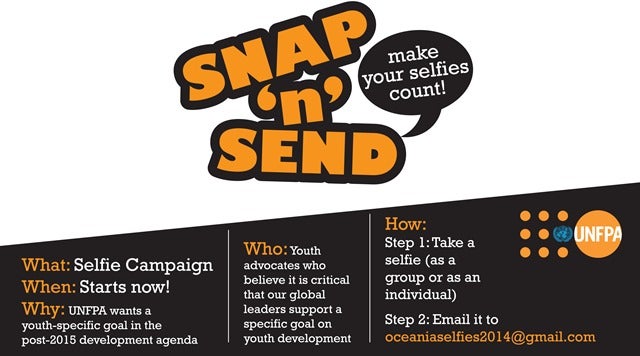From German chancellor Angela Merkel to Pope Francis, people of all walks of life who have access to smart phones are doing it: taking selfies, one can perhaps safely say, is a given in this day and age with the increased accessibility to the virtual world enabled by hand-held devises.
Some selfies by world leaders may not be remembered fondly by the subject themselves for example when the Danish Prime Minister Helle Thorning-Schmidt began taking selfies of herself and the United States President Barak Obama as invitees waited for the start of Nelson Mandela's funeral program - their poses went viral on twitter and famously ended with Mrs Obama moving to sit between them.

However you as an individual, regardless of your age, ethnicity, belief system or profession, are invited to make your selfie count by submitting them to our office, if you support a proposal by the United Nations Population Fund (UNFPA) that a goal specific to youth is a critical component of the post-2015 global development agenda.
The campaign aims to gather millions of selfies from young people, decision-makers themselves, high-profile celebrities and everyone who support the UNFPA proposal for a youth goal in the post-2015 development agenda.
Selfies collected globally will then be used to communicate to decision-makers and world leaders that young people all over the world want to make sure that they are "put in the picture" of future development plans.
The Oceania leg of this global movement was launched by UNFPA Pacific Sub-Regional Office (PSRO) Director and Representative Dr Laurent Zessler on Tuesday (June 24) in Suva.
"Send us a selfie so that the faces of the Pacific will be included in these decision-making processes towards the world's development agenda, express yourself," Dr Zessler said during his presentation that launched the initiative at a national youth and sport conference in Suva, a gathering supported by UNFPA Pacific.
"The UN has eight millennium development goals and as we approach 2015 (the end of the first cycle of this development framework), these MDGs should have been accomplished throughout the world, some have accomplished, some are still working towards it.
"It was a very important fact that no goal was related to young people so we have this idea on a global level that young people should have a specific goal related to empowerment, related to leadership, related to decision-making."
The fields of development work that United Nations member countries mandated UNFPA to work with governments on include issues from the womb to your tomb; the organisation works with governments to ensure accessibility to timely and effective maternal health services as we want to deliver a world where every pregnancy is wanted and where every birth is safe.
UNFPA works very closely with issues relating to young people; the provision of technical support and funding to incorporate comprehensive sexuality education in schools to the provision of youth-friendly services are just two examples. The area of gender and development dynamics, population dynamics and the collation, analysis and effective use of data are cross-cutting to all other aspects of what the organisation does.
UNFPA wants every young person's potential to be fulfilled - if you are student, one should be able to complete his or her education at the highest level one is able to reach. Education has seen over the years the delay in marriage of young women. The positive ripple is endless but a woman empowered by education and who becomes a financial support system for the family, can practice choice when it comes to family formation.
A safe, successful and healthy passage from adolescence into adulthood is the key right of every child and this right can only be fulfilled if families and societies make focused investments and provide opportunities to ensure that adolescents and youth progressively develop the knowledge, skills and resilience needed for a healthy, productive and fulfilling life.
While there has been progress in general when one considers development gains in the last 20 years, Dr Zessler expressed concern at trends that despite the availability of contraceptives like condoms for example, actual utilisation was not as high as expected.
There is thus a lot more potential for Pacific countries like Fiji to address issues young people are grappling with like adolescent pregnancies, unsafe abortions, maternal deaths, Sexually Transmitted Infections including HIV and the still significant gaps in availability, quality and access to comprehensive sexuality education and services for young people.
"The largest generation of adolescents is entering sexual and reproductive life. Safeguarding their rights and investing in their future will not only be beneficial for individual family units but for nations as a whole," Dr Zessler said.
"Adolescents and youth are central to the future development agenda and ensuring they are part of the development agenda is a very critical step.
"I hope that we will all show our support for a development goal that will provide specifically for youth by taking a selfie and sending it to your UNFPA Pacific office."
Selfies can be sent to oceaniaselfies2014@gmail.com . All updates on the campaign will be posted on the organisational website http://www.pacific.unfpa.org and social media platforms including Facebook and Twitter.
The Oceania Snap & Send Selfies Campaign will run until September (2014) when the UN General Assembly gathers to deliberate on the post-2015 global development agenda - so be in the picture to ensure the Pacific is represented in this drive to have a development goal specific to youth.


